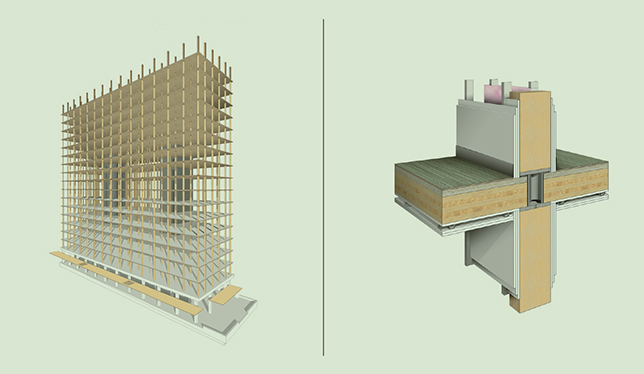A new student residence under construction on the University of British Columbia campus will be one of the tallest wood buildings in the world. UBC says the 18-storey structure builds on the university’s commitment to sustainability and innovation. The eco-friendly structure will stand 53 metres tall and house more than 400 students after its completion, planned for 2017.
Building code regulations in B.C. cap the height of wood buildings at six stories, but exceptions are made for structures created with innovative materials – in this case, mass timber, defined as large dimension engineered wood products including glue-laminated columns and cross-laminated timber floor panels. Proponents of mass timber construction say it is more eco-friendly than using steel or concrete, which emit large amounts of carbon dioxide in their manufacture. Wood, on the other hand, stores carbon dioxide.
The new building is part of an overall plan to add more student residences on campus while supporting local industries, says John Metras, managing director of manufacture and development at UBC. The $51.5-million tower will be funded mainly from student residence fees with some external funding coming from government and private agencies, including Natural Resources Canada and the Canadian Wood Council. This will help to cover the extra costs associated with using a material for the first time, says Mr. Metras.
Some within the construction industry are critical of tall wood buildings because of concerns they may be a fire hazard. To ease these concerns, UBC has taken extra precautions to prevent the spread of fire, including wrapping the walls with three to four layers of protective drywall and capping floors with a concrete topping.
A large wood building under construction in Kingston, Ont., made news when it burned to the ground in a spectacular ball of flames two years ago. But, Mr. Metras says the UBC building does not face the same fire risks as the one in Kingston.
“It’s important to understand this is a mass timber structure. In Kingston, it was 2×4 construction, which has much greater risk for fire,” he says. “Mass timber does not easily ignite and if it does ignite, it typically extinguishes quite quickly. The wood maintains its structural integrity and just chars on the outside.”
The building will also provide study opportunities for UBC researchers and graduate students who will monitor the progress of the building and study mass timber as a building material. This is not the first wood building the university has built and, says Mr. Metras, it won’t be the last. “This is really the next step for us in the evolution of mass timber structures.”
